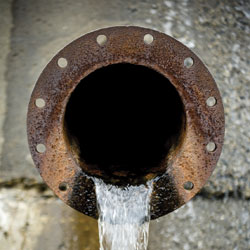
In 2005, the U.S. Congress passed a landmark comprehensive highway bill, sending nearly $300 billion to the states to build and fix long-deteriorating roads and highways. Perhaps eclipsing this is the coming urgency to replace and upgrade our nation’s water infrastructure. Although less apparent, clean water systems across the country are in a similar dilapidated state. To simply continue to meet Environmental Protection Agency (EPA) requirements, the estimated price tag for repair and replacement is in the neighborhood of $300 to $500 billion over the next 20 years, according to The Water Infrastructure Network, EPA and Congressional Budget Office.
Typical water pipe systems are designed to last for 100 years. Today, U.S. cities depend on pipes well beyond their intended life. Aging water systems present numerous issues to water utilities, including increased operating costs, inconvenienced customers, water loss, and in some cases, difficulty meeting EPA standards. Water loss in deteriorated pipe systems can exceed 25 percent, and it is estimated that 60 billion gallons of treated water are lost in the U.S. annually. Corroded pipes are susceptible to contaminates and have a much higher probability of interrupting your morning commute.
With all this in mind, the Peoria district of Illinois American Water, serving 170,900 customers in five communities, has embarked on a comprehensive system evaluation and rehabilitation project which aims to continue to meet or exceed regulatory requirements, reduce public health risk and improve the physical and hydraulic integrity of the system. The top priority of any system rehabilitation is to identify and eliminate problem pipe, as well as identify areas of the system that require investment to meet future demand.
Utilizing the latest hydraulic modeling software and GIS systems, existing water mains are annually assessed using historical data to determine where investments will have the greatest impact. Using a weighted formula accounting for the number of breaks, installation date/age, soil type, pressure loss, pipe water velocity and reliability, each year a list of priority water main replacement projects are executed.
Water pipe segments which frequently break or are expensive to repair are given a high priority for capital expenditure; however, proactive planning also enables Illinois American Water to upgrade less obvious areas of the system. Potential problem areas include those that are subject to unacceptable pressure, are sized inadequately to meet current demand or are trending to unacceptable failure rates. The water model allows the district to make strategic decisions about valve placement, water routing, booster stations and tank usage in order to streamline source pumpage, reduce energy cost and optimize pressure zones. Future demand and community growth are continuously assessed and compared to existing infrastructure to anticipate needed system upgrades, loops and extensions.
Last year, Illinois American Water replaced 38,700 linear feet of compromised water main serving approximately 751 homes or 2,600 customers. Additionally, 2,400 linear feet of new main to meet demand growth was installed for a substantial community investment. Hoping to buck the national trend, Peoria District continues to rehabilitate the past with an eye to the future. IBI

